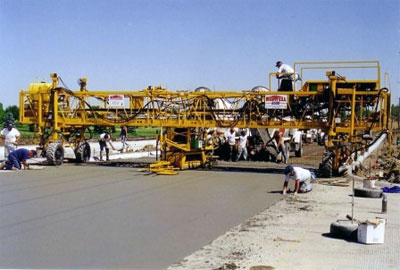Performance
Media Reports

The creation, placement, and curing of concrete are all done on-site, rather than in a factory under uniform conditions. Although pervious concrete can be mixed by the same suppliers and delivered by the same trucks as dense concrete, its unique physical characteristics require a contractor with specialized experience. The structural dissimilarities between pervious and impervious concrete call for different installation processes, neither of which is more difficult or time-consuming than the other. However, the quality and performance of pervious concrete are dependent upon the installer’s familiarity with the constructional impact of its properties. This can be gained only through hands-on experience with the substance, which is not a commonly-used building material in all locales.
Appropriate construction techniques are necessary to ensure the performance of pervious concrete. It has a relatively stiff consistency, which dictates its handling and placement requirements. The use of a vibrating screed is important for optimum density and strength. After screeding, the material is usually compacted with a steel pipe roller. There are no bullfloats, darbies, trowels, etc. used in finishing pervious concrete, as such tools tend to seal the surface. Joints, if used, may be formed soon after consolidation or installed using conventional sawing equipment (however, sawing may induce raveling at the joints). Some pervious concrete pavements are placed without joints. Curing with plastic sheeting must start immediately after placement and should continue for at least seven days. Careful engineering is required to ensure structural adequacy, hydraulic performance, and minimum clogging potential. Click here for more information on these topics.
 After placement, pervious concrete has a textured surface which many find aesthetically pleasing and which has been compared to a Rice Krispies® treat. Its low mortar content and little (or no) fine aggregate content yield a mixture with a very low slump, and with a stiffer consistency than most conventional concrete mixtures. In spite of the high voids content, properly placed pervious concrete pavements can achieve flexural strengths of more than 500 psi (3.5 MPa). This strength is more than adequate for most low-volume pavement applications, including high axle loads for garbage trucks and emergency vehicles such as fire trucks. More demanding applications require special mix designs, structural designs, and placement techniques. Currently there is no ASTM test standard for compressive strength of pervious concrete. Testing variability measured with various draft test methods has been found to be high and therefore compressive strength is not recommended as an acceptance criterion.
After placement, pervious concrete has a textured surface which many find aesthetically pleasing and which has been compared to a Rice Krispies® treat. Its low mortar content and little (or no) fine aggregate content yield a mixture with a very low slump, and with a stiffer consistency than most conventional concrete mixtures. In spite of the high voids content, properly placed pervious concrete pavements can achieve flexural strengths of more than 500 psi (3.5 MPa). This strength is more than adequate for most low-volume pavement applications, including high axle loads for garbage trucks and emergency vehicles such as fire trucks. More demanding applications require special mix designs, structural designs, and placement techniques. Currently there is no ASTM test standard for compressive strength of pervious concrete. Testing variability measured with various draft test methods has been found to be high and therefore compressive strength is not recommended as an acceptance criterion.


